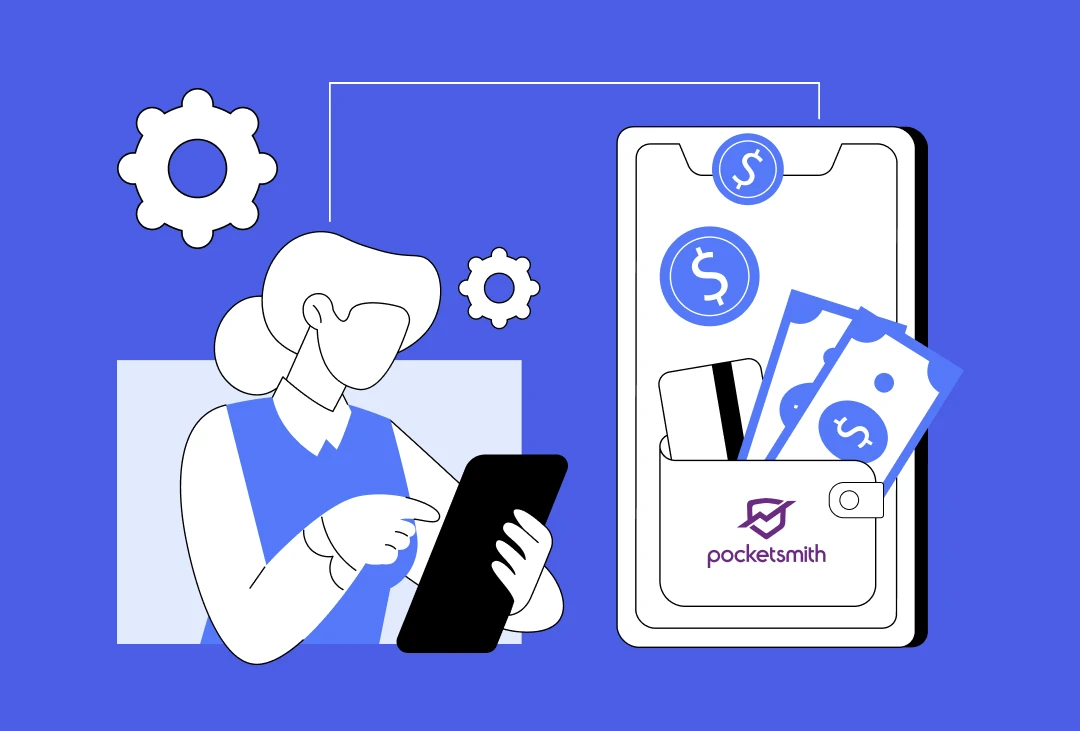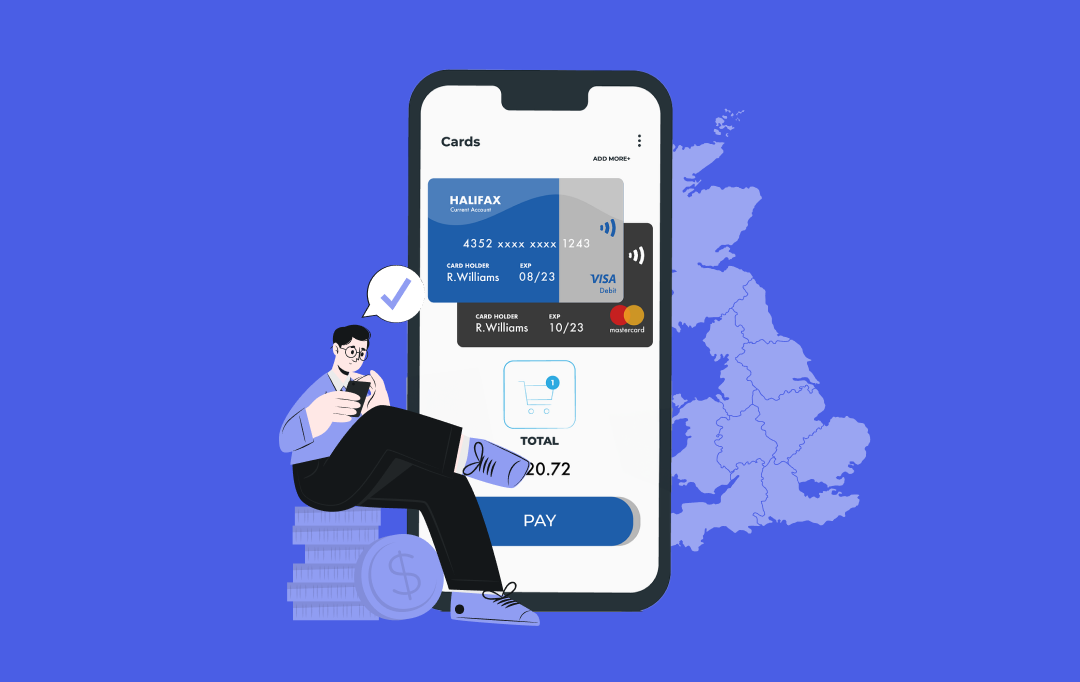- What is WealthTech?
- A Breakdown of Wealth Management Value Chain
- Benefits of FinTech in Wealth Management
- Increased Accessibility
- Personalization
- Cost Savings
- Enhanced User Experience
- Stronger Security
- Improved Transparency
- Higher Efficiency
- Better Risk Management
- Increased Revenue Potential
- Adherence to Regulatory Compliance
- WealthTech Use Cases in Traditional Finance
- Automated Advisory Services
- Consolidated Dashboards
- Retail Algorithmic Trading Services
- Biometric User Authentication
- Blockchain Transactions
- Big Data Analytics for Opportunities
- Mobile Banking Apps
- AI Virtual Assistants
- Crowdfunding Investment Platforms
- Compliance Process Automation
- How To Develop a Wealth Management App?
- Step 1: Requirements Gathering
- Step 2: Design & Prototyping
- Step 3: App Development
- Step 4: Back-end Integration
- Step 5: Compliance & Security
- Step 6: Testing, Launch & Ongoing Support
- What is the Cost to Develop a WealthTech App?
- Features to be Integrated in a WealthTech App
- Automated Portfolio Management
- Financial Planning
- Strategic Tax Management
- Retirement Strategies
- Portfolio Monitoring
- Support Services
- Data Security
- Financial Analytics
- Goal Setting and Tracking
- Seamless Integration
- A Quick Look into the Promising Future of WealthTech
- Hyper-Personalization through AI
- Democratization of Investing
- Expansion of Alternative Investments
- Open Finance and Embedded Wealth
- Immersive Digital Experiences
- Advanced Risk Analytics
- Compliance and RegTech Integration
- How Appinventiv Can Help You Leverage the WealthTech Space
- FAQs
The financial services industry is undergoing massive disruption driven by emerging technologies like artificial intelligence, machine learning, and blockchain. This new wave of innovation is giving rise to a new era in finance called WealthTech or wealth management technology, which focuses on leveraging these technologies to enhance wealth management and financial advisory services.
According to Allied Market Research, WealthTech enterprise solutions are projected to reach $18.6 billion by 2031 at a CAGR of 14.8%, up from $4.8 billion in 2021. The pace of adoption is only expected to accelerate as established institutions and startups continue to invest heavily in digital transformation.

FinTech in wealth management aims to improve the client experience, increase efficiency, and lower costs across the whole value chain. It encompasses many solutions, from robo-advisors and portfolio management software to client analytics.
As traditional finance adopts these technologies, the benefits are profound for institutions and end clients. This article will provide an overview of WealthTech app development, the key benefits it offers, and use cases of WealthTech in financial innovation.
What is WealthTech?
WealthTech combines wealth management and technology to transform how funds and assets are handled. It utilizes innovations like artificial intelligence, machine learning, and blockchain to improve personal finance and investing. WealthTech developers build applications that automate manual wealth management processes and provide customized financial recommendations powered by AI.
This reduces the workload for wealth managers so they can focus on high-value services. For users, FinTech wealth management tools enable more informed decision-making around investments, budgets, and wealth planning.
FinTech in wealth management solutions analyze financial data to optimize wealth while lowering risks. They also allow users to easily track budgets, monitor investments, and get alerts on performance. WealthTech aims to make managing money and assets more efficient, accessible, and personalized through smart automation and data-driven insights.
[Also Read: How AI is Revolutionizing Asset Management: Key Benefits and Use Cases]
By adopting these technologies, both managers and clients benefit from enhanced services and better outcomes. WealthTech marks an exciting shift towards more user-friendly, effective wealth management software development.
A Breakdown of Wealth Management Value Chain
As stated by McKinsey, the wealth management technology (WealthTech) industry can be categorized into three main archetypes based on how they serve customers:
- Direct-to-Consumer WealthTechs (D2C): These are digital platforms that provide investment management and advice directly to retail investors across the wealth spectrum. They offer access to public assets like ETFs and mutual funds and private assets like real estate and startup investments. D2C WealthTechs aims to make personalized financial advice easily accessible to the mass market in an affordable way.
- WealthTech Solution Providers to Financial Institutions (B2FI): These B2B WealthTech firms provide technologies to help traditional financial institutions transform their wealth management capabilities. Solutions range from front-end client portals to back-end integrations across the value chain. Modular platforms enable institutions to update specific functions or the entire wealth management process.
- WealthTech Solution Providers to Financial Advisors (B2FA): This segment focuses on empowering financial advisors with digital tools to serve clients more efficiently. Solutions aim to enhance advisor capabilities while offering clients a seamless digital experience for tracking investments. The platforms help advisors dedicate more time to client service by automating administrative tasks.
A key trend is using technology to expand access to wealth management services through easy-to-use, affordable platforms. WealthTechs are moving toward fee-based pricing models rather than traditional commissions. They utilize innovations like AI, blockchain, and tokenization to open new investment opportunities.
Benefits of FinTech in Wealth Management
Wealth tech is revolutionizing traditional practices, making them more automated, accessible, and transparent. Here are the 10 key benefits of WealthTech for both end users and organizations.

Increased Accessibility
Wealth tech expands access to financial services by lowering barriers posed by traditional brokers like high account minimums, restricted geographic service areas, and the need for in-person interactions. For instance, leading robo-advisors like Betterment and Wealthfront only require a few hundred dollars to open and manage accounts through user-friendly web/mobile platforms accessible from anywhere. This levels the playing field for retail investors.
Personalization
Sophisticated algorithms allow vast datasets to enable WealthTech solutions to provide tailored product recommendations and portfolio allocations aligned to each investor’s financial goals, risk tolerance, and liquidity needs. Contextual nudges and notifications enhance user engagement by further customizing the experience. When it comes to FinTech in the wealth management ecosystem, these technologies represent a significant opportunity for investors to harness the power of data for more informed decision-making.
Cost Savings
FinTech wealth management solutions automate large parts of operations, portfolio management, trading execution, and advisory services leveraging process automation and AI. This significantly reduces the need for expensive human advisors and infrastructure. Further, web/mobile delivery models lower distribution costs. The ensuing cost savings can be passed to end users making services affordable.
Enhanced User Experience
Leading WealthTech apps feature slick, intuitive user interfaces that engage users. Flexible online account opening, seamless advisory chatbots, consolidated financial data views, interactive dashboards, and instant transaction alerts propel user experiences light years ahead.
Stronger Security
Biometric login authentication, mandatory multi-factor authorization, end-to-end encryption, distributed ledger technology, centralized data monitoring and advanced cybersecurity infrastructure make WealthTech far more resilient to data and financial threats. Security is heightened compared to traditional systems.
Improved Transparency
Wealth platforms incorporating open API architectures, personalized notifications, interactive dashboards, and automated reporting enable unprecedented transparency to investors on holdings, investment performance, strategies, fees, and upcoming financial moves by their providers.
Higher Efficiency
Streamlining wealth management processes through automation and AI-powered enhancements sharply improves operational efficiency. This translates to reduced errors, faster transaction processing, lower information requests, and quick scaling up of client bases without an equivalent cost rise.
Better Risk Management
Wealth tech apps integrate scenario analysis, cash flow modeling, portfolio stress testing, and exposure calculation modules utilizing predictive analytics and data science techniques to evaluate and mitigate risk better. This factor is essential, given wealth involves recommending investment products with complex, leveraged structures.
Increased Revenue Potential
The agile, API-based platforms WealthTechnology firms utilize provide real-time visibility into client activity and flexibility to add new partnership channels. This fosters faster innovation and the ability to capture evolving revenue opportunities other organizations may miss out on.
Adherence to Regulatory Compliance
Integrating compliance processes like KYC (Know Your Customer) verification, transaction monitoring, and risk rating into account opening and advisory workflows provides immense efficiency benefits in meeting regulations like AML (Anti Money Laundering) and fiduciary standards. It also provides comprehensive audit trails to demonstrate compliance during regulatory exams.
WealthTech Use Cases in Traditional Finance
Wealth management includes various financial services traditionally handled by human advisors – from investments and trading to budgeting to taxes and estate planning. WealthTech innovation is modernizing service delivery across the client lifecycle journey. Let’s look at some of the real-world WealthTech use cases demonstrating this transformation.

Automated Advisory Services
Robo advisory platforms are automating wealth management guidance using AI algorithms. They analyze investor profiles and financial goals to enable personalized recommendations on asset allocation, portfolio construction, rebalancing, and tax optimization.
Consolidated Dashboards
Data aggregator apps seamlessly pull together client account data from distributed sources across different wealth managers, banks, brokerages, investment companies, pension funds, and insurance firms onto unified dashboards. This simplification greatly benefits businesses by reducing the complexity and manual effort involved in managing client information across different platforms.
Retail Algorithmic Trading Services
Wealth tech apps incorporate sophisticated machine learning algorithms to execute equity, options, and cryptocurrency trades aligned to customized risk profiles for retail investors. This brings institutional-class trading infrastructure to individual investors to tap opportunities.
Biometric User Authentication
Startup businesses are securing wealth account access using advanced biometrics tracking behavioral and physiological user parameters that are far tougher for fraudsters to spoof. Fingerprint scans, facial recognition, voice verification, and behavioral analytics identify genuine users.
Blockchain Transactions
Cryptocurrency exchanges and decentralized lending/borrowing apps utilize blockchain infrastructure for transparent, efficient wealth transactions. User activities get permanently recorded as encrypted entries on distributed ledgers providing enhanced integrity.
Big Data Analytics for Opportunities
Wealth tech apps equipped with AI engines mine and analyze client 360 data, spending patterns, market indicators, M&A databases, clinical trial updates and various other datasets to derive timely signals on promising investment opportunities to recommend.
Mobile Banking Apps
Wealth tech mobile apps provide individuals real-time visibility into customized investment portfolio dashboards, ability to instantly move funds, integrated buy/sell trading execution, budgeting assistance, loyalty rewards tracking and connectivity to virtual assistants like Alexa while on-the-go.
[Also Read: The Cost and Benefits of Developing an AI-Powered Smart Personal Assistant App]
AI Virtual Assistants
Chatbots like Erica from Bank of America provide wealth management clients conversational ability to check financials, get market updates, receive spending insights and request account transfers without needing human reps. This delivers service 24/7 not limited by call center availability.
Crowdfunding Investment Platforms
Portals like RealCrowd and EquityMultiple enable wealth managers to give retail investors early investment exposure to curated institutional-grade real estate development and private company deals that previously required $1 Million+ minimums.
Compliance Process Automation
Wealth platforms have embedded compliance steps like customer risk scoring, negative news monitoring, ID verification and transaction pattern flagging natively into account opening and transaction flows using AI in WealthTech for straight-through processing. This boosts efficiency in meeting regulatory obligations.
How To Develop a Wealth Management App?
Developing a wealth management app requires strategic planning and cutting-edge technology to meet the evolving needs of today’s investors. Let’s dive into the essential steps and considerations for creating an app that stands out in the competitive WealthTech landscape.

Step 1: Requirements Gathering
The first step is to clearly define the app’s requirements based on extensive research into the target users, their needs, pain points, and goals. This could involve surveys, interviews, usability studies etc. Some common requirements for wealth management app development include:
- Portfolio tracking across multiple accounts/assets
- Automated investment management and rebalancing
- Financial planning tools and calculators
- AI-driven personalized recommendations
- Secure account funding and money transfers
- Interactive reporting and data visualization
Step 2: Design & Prototyping
Once requirements are documented, the next phase for wealth management software development is designing the user experience (UX) and user interface (UI). This involves:
- Creating user flows, wireframes and prototypes
- Defining the visual design style guide
- Building clickable prototypes for user testing
- Iterating on the designs based on feedback
Step 3: App Development
With finalized requirements and designs in place, the development team can proceed to build the actual WealthTech app. This phase of wealth management app development entails crucial decisions, such as selecting the appropriate tech stack, which often includes cross-platform frameworks like React Native for seamless deployment across multiple platforms. Integrations with third-party data providers and APIs are implemented to ensure the app has access to the necessary financial data and services.
Step 4: Back-end Integration
WealthTech apps require robust back-end integrations to seamlessly connect with existing financial systems and services. This may involve establishing connections with banks and brokerages via APIs for account aggregation, linking to customer relationship management (CRM) systems and existing advisor tools, integrating with trade execution and portfolio accounting platforms, and setting up scalable cloud infrastructure to handle the app’s computational demands.
Step 5: Compliance & Security
Financial companies must follow strict security and privacy rules carefully during making new programs. This means protecting customer data under laws like GDPR, thoroughly testing for hacks and security reviews, complying with financial advisor laws, and logging activities to check requirements are met.
Step 6: Testing, Launch & Ongoing Support
Once the development and testing phases for WealthTech app are finalized, it moves on to be available on app stores for users. Yet, the work doesn’t stop there for the development team. Continuous support and maintenance is essential for the app’s success, involving performance tracking, bug fixing, customer assistance with FAQs, enhancing features based on user data, and regular updates to adapt to system changes and new requirements.
What is the Cost to Develop a WealthTech App?
For a professionally designed and developed WealthTech app with robust functionality, you can expect the cost to develop a WealthTech app ranging from $35,000 to $250,000, or higher. Let us look at the several factors that impact the exact cost to develop a wealth management app.

- App Complexity & Features: The main cost driver is the scope and complexity of features required. A basic app with limited functionality like portfolio tracking will be on the lower end. WealthTech app features like automated investment management, AI-driven analytics, and advanced reporting will be more costly.
- Design: High-quality UI/UX design is critical for any finance app’s success. Professional design services typically cost $10,000-$30,000 depending on the amount of screens and animations involved.
- Native vs Cross-Platform: Building separate native iOS and Android apps is more expensive than cross-platform solutions like React Native that share a codebase.
- Third-Party Integrations: Integrating with bank data aggregators, trading platforms, CRM systems etc. adds complexity and cost.
- Development Team Location: Prices for FinTech developers can vary tremendously between the U.S. ($100-$200/hr), Eastern Europe ($30-$100/hr), and India ($20-$80/hr).
- Backend Infrastructure: Setting up secure, scalable cloud infrastructure on AWS or similar for the app backend can cost $10,000+.
- Security & Compliance: Ensuring the app meets data privacy, financial compliance, and security certifications requires audits that add costs.
- Testing & QA: Rigorous multi-phase testing across various scenarios, platforms and real-world conditions is essential but adds 20-30% to costs.
- Maintenance & Updates: Ongoing costs for app updates, enhancements, technical support etc. amount to 15-25% of initial development annually.
In general, the cost to develop wealth management software is $30,000-$100,000 while a more comprehensive solution may cost upwards of $150,000-$250,000 or more depending on the complexity.
Features to be Integrated in a WealthTech App
There are multiple WealthTech app features that cater to the diverse needs of today’s savvy investors, aiming to simplify and enhance their financial management experience. Let’s look at them in detail below.

Automated Portfolio Management
Offers automated investment portfolios, personalized investment strategies, and access to real-time market insights.
Financial Planning
Provides comprehensive tools for effective budgeting, savings plans, and long-term financial forecasting.
Strategic Tax Management
Includes features for tax-loss harvesting, strategies for tax-efficient investing, and comprehensive tax planning.
[Also Read: How Much Does it Cost to Build a Tax Preparation App Like TurboTax?]
Retirement Strategies
Tools like retirement savings calculators and tailored investment advice for efficient Social Security and retirement planning.
Portfolio Monitoring
Enables real-time monitoring of portfolio performance, including risk assessment and adherence to market trends.
Support Services
Round-the-clock customer support and access to financial advisors for making well-informed financial decisions.
Data Security
Employs top-tier security protocols to safeguard users’ financial data and investment details.
Financial Analytics
Advanced reporting and analytics features for custom financial reports and tracking investment performance.
Goal Setting and Tracking
Allows users to set financial goals and monitor progress, offering motivational insights and achievements.
Seamless Integration
Easily integrates with other financial tools and services for a holistic view of personal finances, enhancing convenience and efficiency.
A Quick Look into the Promising Future of WealthTech
The future of WealthTech looks incredibly promising and transformative. Here are some of the key WealthTech trends and developments that will shape WealthTech in the FinTech landscape in the coming years.

Hyper-Personalization through AI
Artificial intelligence and machine learning will enable an unprecedented level of hyper-personalized wealth management technology services. Intelligent algorithms will deeply understand each client’s unique financial situation, goals, risk tolerance and preferences to provide highly customized advice, recommendations and portfolio management.
Democratization of Investing
WealthTech in FinTech will continue democratizing investing by making sophisticated wealth solutions more accessible and affordable to the mass market. Robo-advisors, micro-investing apps and fractional trading platforms will open up new asset classes and investment strategies to retail investors. This evolution within fintech in investment management makes way for a pivotal shift, as technology bridges the gap between complex investment opportunities and the general public.
Expansion of Alternative Investments
The tokenization of alternative assets like real estate, art, startups etc. on blockchain platforms will provide liquidity and allow easier, fractionalized investing. WealthTech will facilitate this access to previously exclusionary alt-investments.
Open Finance and Embedded Wealth
Open banking APIs and embedded finance solutions will enable the seamless integration of banking, lending and wealth services into a unified experience within non-financial apps and platforms.
Immersive Digital Experiences
Immersive technologies like augmented/virtual reality, gamification and interactive data visualization will transform how investors engage with their portfolios, interact with advisors and manage their finances.
Advanced Risk Analytics
Big data analytics combined with AI will allow advanced risk modeling, portfolio stress testing and predictive insights at an individual investor level to optimize wealth preservation.
Compliance and RegTech Integration
Embedded compliance solutions leveraging technologies like blockchain will streamline regulatory processes like investor onboarding, audits and reporting across the WealthTech ecosystem.
How Appinventiv Can Help You Leverage the WealthTech Space
WealthTech is rapidly transforming wealth management in the FinTech industry, introducing efficiencies and growth opportunities through artificial intelligence, data analytics, and digital solutions. As the sector evolves, choosing the right technology partner becomes crucial. Appinventiv can be your dedicated WealthTech development partner, boasting robust FinTech expertise in AI, compliance, and more.
As a leading FinTech app development company, Appinventiv brings extensive experience and deep expertise to help you build a robust and successful WealthTech application. Our custom-made finance applications have enabled real business impact and growth for our clients:
- Mudra: An AI-powered budget management app designed to educate millennials on financial literacy through gamification and interactive experiences. The app provides personalized insights to encourage better money habits.
- Edfundo: A FinTech startup that developed a financial education and money management app with AppInventiv. Our collaboration led to Edfundo securing $500K in pre-seed funding and recognition as the Best FinTech Startup.
Whether you are an established wealth manager or an ambitious FinTech disruptor, Appinventiv has the proven skills to convert your dream into a reality. Our team of FinTech developers and designers possess specialized expertise in areas like AI, data analytics, secure mobile platforms and more.
Based on design thinking principles, Appinventiv builds intuitive apps aligned with your brand identity and business goals. Our full-cycle capabilities ensure smooth deployment, integration with existing systems, and ongoing support for enhancements.
Get in touch with our experts to craft a tailored WealthTech solution that perfectly aligns with your needs.
FAQs
Q. How does WealthTech differ from traditional financial advisory services?
A. Wealth technology employs algorithms, extensive data analysis, and artificial intelligence to provide extremely personalized advice and round-the-clock availability, surpassing conventional human advisory structures. Digitization in wealth management not only streamlines operations but also enhances client engagement through interactive platforms, thereby offering a more efficient, accessible, and cost-effective alternative to traditional financial advisory services.
Q. Is WealthTech only for affluent investors?
A. No, WealthTech isn’t just for affluent investors. By leveraging technology to automate and enhance the processes, WealthTech solutions are revolutionizing the field of wealth management in the FinTech industry. The democratization of personalized financial advice and investment strategies is a key achievement. This makes sophisticated financial services accessible and affordable to a broader range of clients, from the mass market to the mass-affluent and even high-net-worth individuals.
Q. What timeframe does it take to build a WealthTech solution?
A. A typical functional financial technology application usually undergoes a development and thorough testing phase lasting between 3 to 5 months before becoming operational. More extensive solutions typically necessitate an average of 8 to 12 months for completion.



How Much Does it Cost to Build a Personal Finance App like Pocketsmith?
Imagine an app that knows when your rent is due, reminds you of upcoming bills, forecasts your savings 12 months ahead, and tells you if that third coffee this week is wrecking your budget. That’s the kind of experience apps like PocketSmith deliver, and it’s exactly why personal finance apps are becoming a must-have for…

How Much Does it Cost to Build a Mobile Banking App Like Halifax in the UK?
The way people bank has changed dramatically. Gone are the days of waiting in long queues or rushing to a branch before closing hours. Today, mobile banking apps like Halifax have redefined convenience, allowing users to check balances, transfer funds, pay bills, and even apply for loans from their smartphones, anytime and anywhere. This shift…

How to Approach Currency Converter App Development?
Imagine you’re about to travel abroad and need to quickly check how much your local currency is worth in another country, or perhaps you run an international business and constantly deal with multiple currencies. In both cases, a currency converter app is an indispensable tool. With global transactions becoming the norm and forex markets fluctuating…

















